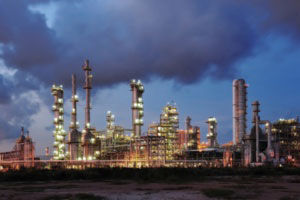This story is part of a series, "Model Workplaces, Imperiled Workers," by the Center for Public Integrity's iWatch News.
On a December night in 2009, something went wrong at Valero’s oil refinery in Texas City, Texas. Technician Tommy Manis and his co-workers weren’t sure just what it was. They had tried more than a dozen times to get a boiler started. They weren’t aware of the dangerous levels of gas building up inside, ready to ignite.
With Manis and his co-workers nearby, gas flowed unchecked into the boiler, which had had previous problems that Manis and his coworkers were unaware of. There was a certain degree of trust among the crew, though.
.
OSHA had formally certified the Valero refinery as a “model workplace” with an exemplary record and a safety program exceeding that required by regulators. It was a “Star” site in the agency’s VPP — a distinction that, for Valero, conveyed more than just bragging rights. OSHA exempts members of this elite club from some inspections, including the special enforcement program targeting refineries and similar initiatives designed to address hazards in some of the nation’s most dangerous industries.
.
The VPP flag can attract and reassure workers. A red, white and blue symbol of the government’s approval, it flies at nine of Valero’s refineries. Manis had received T-shirts, pens and Christmas ornaments stamped with the program’s logo — gifts from his employer. The refinery’s reputation, his wife recalled, had drawn Manis to apply for the job in the first place: “He thought Valero was the cream-of-the-crop plant. It didn’t blow up. It was safe.”
That December night, while in her car, Laura received a text message: Had she heard what happened at the refinery? She knew Tommy was in the middle of a shift. She dialed the sender and asked what was going on. “There was dead silence on the phone, and I knew,” she recalled.
Investigators would later determine that Tommy’s death could have been prevented. Valero hadn’t adequately investigated the first boiler explosion or taken proper steps to prevent it from recurring, OSHA found. The agency determined that the company hadn’t adequately trained workers, evaluated dangers or ensured the problematic boiler conformed to widely accepted safety standards.
Though Valero blames the companies that manufactured and installed the boiler in an ongoing lawsuit, OSHA found fault with Valero, issuing a serious violation and highlighting a half-dozen safety problems. In a June 2010 settlement with the agency, Valero agreed to fix problems at the refinery but didn’t admit to violating safety regulations. The company paid a $4,500 fine.
When the boiler exploded, Tommy Manis became the fourth worker at a VPP “Star” refinery to die since the special inspection program began in mid-2007. Since his death, three more workers have died at one of these government-recognized refineries. Yet all five plants where the seven workers died retain OSHA’s stamp of approval today, an investigation by the Center for Public Integrity’s iWatch News has found.
Not only have workers died at VPP refineries, those plants appear to have some of the same problems plaguing the refining industry as a whole.
Fires are a primary concern. Refineries are fuel factories that use highly flammable chemicals. Even small fires can be indicators of how well refiners are managing hazards that can lead to catastrophic explosions or toxic chemical releases. Regulations require companies to evaluate potential dangers, test equipment, and investigate mishaps as part of what is known as “process safety management” — the focus of the OSHA enforcement initiative targeting refineries.
During 2009 and 2010, at least 21 of 55 fires at refineries falling under federal jurisdiction occurred at VPP sites, an iWatch News analysis of regulatory and news media reports found.
The patchwork regulatory system in which OSHA officials can conduct routine inspections and find violations at some workplaces while others are off-limits exists even within companies; oil giants such as ExxonMobil, ConocoPhilips and Valero own both VPP and non-VPP refineries, so some of their plants are shielded from special inspections while others aren’t.
At refineries that inspectors can visit as part of the special enforcement initiative, they frequently have found serious safety violations.
In March 2005, an explosion killed 15 people and injured 180 more at BP’s Texas City refinery, just a short drive from where Manis would die four years later. The U.S. Chemical Safety Board, the independent federal agency that investigated the BP disaster, in 2007 urged OSHA to start a “national emphasis program” that would give special scrutiny to refiners in an attempt to curb hazards before disaster strikes.
OSHA shared concerns about the industry. “As a result of the Texas City accident, OSHA began evaluating its data on fatalities and catastrophes and determined that refineries experienced more of these problems than the next three industry sectors combined,” Richard Fairfax, who headed the agency’s enforcement programs, told a congressional subcommittee n 2007.
OSHA took the board’s advice and started the emphasis program later that year, focusing on process safety management — the control of dangers associated with the use of highly hazardous substances that could lead to fires, explosions or chemical releases. The agency planned to inspect every oil refinery under federal jurisdiction. Except those in the national emphasis program
The oil refining industry has been among VPP’s strongest supporters. Two of the program’s staunchest supporters in Congress — Sens. Mike Enzi, R-Wyo., and Mary Landrieu, D-La. — received more than a half-million dollars combined in contributions from the oil industry since 2005, according to data from the Center for Responsive Politics. Overall, the industry spent almost $146 million to lobby the federal government in 2010.
The president of the refiners’ association, Charles Drevna, sent OSHA chief David Michaels a letter last year, urging continued support for VPP. “There is no need for OSHA to revisit and inspect VPP worksites as part of the Refinery Process Safety National Emphasis Program,” Drevna wrote.



